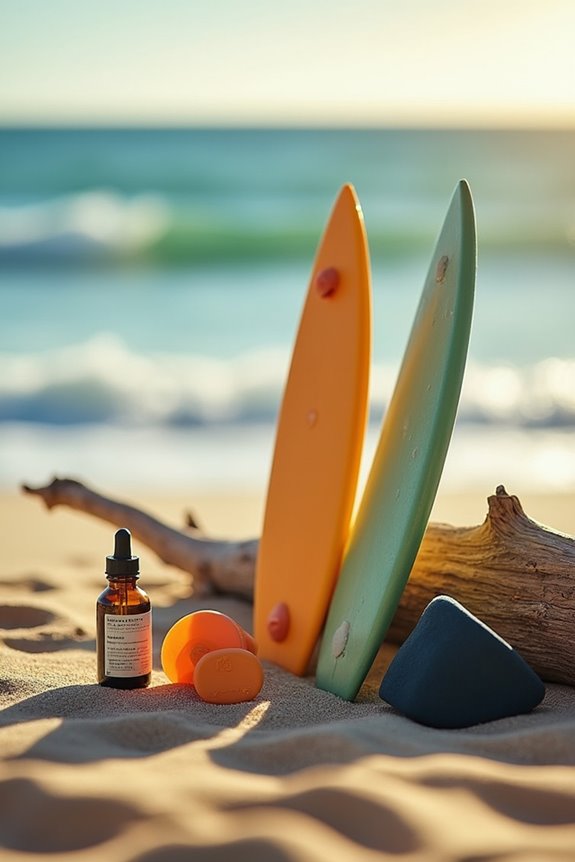To explain surfing obsession to non-surfers, we can highlight several key aspects. Surfing offers physical benefits, like improved cardiovascular health and strength, alongside mental advantages, including stress relief and emotional restoration. The adrenaline rush and dopamine release during rides create a thrilling experience similar to addiction. Additionally, surfers build strong community ties, finding camaraderie and support within surf culture. As we explore these factors further, we can understand the deep allure and impact surfing has on our lives.
Key Takeaways
- Surfing is a unique blend of physical workout, adventure, and mental clarity, creating an irresistible allure for those who participate.
- The thrill of catching waves releases dopamine and endorphins, leading to a euphoric state that enhances the desire to surf.
- Surfing fosters strong community bonds, providing social connections that reduce isolation and enhance overall well-being.
- Each surf session is a new adventure, presenting challenges that push personal limits and encourage growth.
- The deep connection with nature while surfing offers emotional restoration and a meditative escape from daily stressors.
The Physical and Mental Health Benefits of Surfing
Surfing offers a range of physical and mental health benefits that can enhance our overall wellbeing. Engaging in surfing provides a dynamic workout, improving cardiovascular health and lung capacity while building upper body strength. This full-body activity enhances our physical fitness by promoting endurance, balance, and flexibility.
Moreover, surfing’s connection to natural water environments contributes to mental clarity. Just a 30-minute session can lift our mood, reduce stress, and combat feelings of anxiety and depression. The immersive experience encourages us to focus on the present, fostering emotional restoration. Additionally, the use of quality surfboards can significantly impact performance, making the experience even more rewarding.
Neurochemical Responses and the Thrill of the Waves

Understanding the neurochemical responses involved in our surfing experiences can shed light on why many of us feel an irresistible pull toward the ocean. One key player is dopamine, a neurotransmitter that controls our brain’s reward system. The anticipation of catching waves releases dopamine, motivating us to seek out these experiences repeatedly.
When we successfully ride a difficult wave, we experience dopamine surges, reinforcing our desire to surf again. This dynamic is similar to substance addiction, as our brains crave the pleasure associated with these moments. Additionally, surfing releases endorphins, which enhance our mood and mask discomfort, creating a euphoric state. Together, these neurotransmitter dynamics explain the powerful thrill we feel when we hit the waves. Moreover, practicing yoga can further enhance this euphoric state by improving flexibility and balance, which are crucial for surfing performance.
Building Community and Social Connections Through Surfing

The thrill of riding waves often brings surfers together, creating a sense of community that goes beyond the individual experience. Through shared ocean adventures, we form surfing friendships that combat social isolation, especially among younger generations. Groups like Intersxtn Surf and initiatives from platforms like Hinge help foster community bonding by organizing surf activities that encourage interaction. Surfing not only enhances personal enjoyment but also provides opportunities for communal engagement. These connections help reduce feelings of social anxiety, making us feel included and supported. In surf communities, we experience higher levels of well-being and resilience, as the mutual support and shared identity strengthen our ties to each other and our environment. Additionally, participating in local surf competitions can further deepen these connections by fostering teamwork and camaraderie among surfers.
Understanding Surfing Obsession Through Addiction Analogies

When we examine the parallels between surfing obsession and addiction, it becomes clear that both involve a deep-seated compulsion driven by cravings. Surfing addiction, much like substance dependence, activates reward pathways in our brains. This can lead us to engage in repetitive behavior despite negative consequences.
The concept of “urge surfing” in addiction therapy mirrors the flow state we seek while surfing. Both experiences emphasize mindfulness over impulsivity, allowing us to navigate our cravings nonreactively.
Additionally, just as addiction can hijack our brain’s reward circuits, our obsessive pursuit of surfing often reflects deeper psychological needs. These craving parallels highlight how both surfing and addiction can serve as tools for emotional regulation and fulfillment, fostering a sense of connection and purpose. Essential surfing accessories can enhance this experience, providing the necessary tools for both safety and enjoyment in the water.
The Unique Environment of Surfing and Its Impact on Engagement

Exploring the environment in which we surf reveals significant influences on our engagement with the sport. Wave dynamics, shaped by geomorphological features like reefs and sandbars, determine the quality of our surf. These natural factors create unique conditions that require us to adapt our skills and strategies, fostering a deeper connection with the ocean.
However, coastal ecosystems face threats from climate change, coastal erosion, and human activities. As wave patterns and surf breaks change, our experience can diminish, impacting our motivation to surf. Understanding these environmental conditions enhances our appreciation for the sport and encourages us to advocate for the preservation of these essential ecosystems, ensuring future generations can enjoy surfing as we do. Additionally, the surf conditions vary by season, influencing when we choose to surf and how we prepare for our sessions.
The Cultural Significance of Surfing in Identity Formation
Understanding surfing’s cultural significance offers insights into how it shapes our identities and communities. For Indigenous Hawaiians, surfing represents resistance against colonialism and assimilation. Traditional practices reflect ancestral narratives, linking modern surfers to historical chieftains who embodied strength and leadership.
Surfing serves as a cultural and political space where identities are negotiated and preserved. It fosters a sense of belonging, connecting individuals to their heritage and shared values. Moreover, surfing’s role in local and global contexts contributes to diverse cultural identities. It encourages community cohesion while also maneuvering the complexities of tourism and authenticity. Ultimately, recognizing these cultural dimensions enriches our understanding of surfing as more than just a sport; it’s integral to our identity formation.
Emotional Resilience and Coping Mechanisms in Surfers
Emotional resilience and effective coping mechanisms are essential aspects of the surfing experience. Through surf therapy, participants often see improvements in emotional regulation, enabling them to manage stress better. Engaging with the unpredictable ocean helps us confront our fears and anxieties, enhancing our coping strategies.
Key benefits include:
- Improved Emotional Expression: Surf therapy promotes healthier emotional expression rather than suppressing feelings.
- Increased Resilience: Regular exposure to the challenges of surfing boosts our capacity to recover from adversity.
- Social Support: Surf communities provide encouragement, creating a safe space for shared experiences and coping strategies.
The Meditative Experience of Riding Waves
The experience of riding waves can be profoundly meditative, as we become fully immersed in the moment, allowing the chaos of life to fade away. Through mindful awareness, we focus on our wave connection, feeling the rhythm of the ocean. This intense focus helps us practice mindfulness, reducing stress and enhancing mental clarity.
As we paddle out and ride waves, we enter a flow state that promotes deep concentration and intrinsic motivation. The physical exertion triggers endorphin release, enhancing feelings of euphoria. Additionally, the ocean environment fosters a sense of connection to nature, promoting emotional regulation. Overall, surfing offers a unique blend of physical activity and mental tranquility, contributing to our well-being.
Frequently Asked Questions
What Gear Do Surfers Need to Get Started?
To get started, we need a stable longboard for easy paddling, a wetsuit for warmth and protection, and essential accessories like a leash and surf wax. These items help guarantee our safety and enhance our experience.
How Can Beginners Safely Learn to Surf?
Learning to surf’s like dancing with the ocean. We should master beginner techniques, focusing on safety tips like choosing gentle waves and understanding currents, ensuring our first moves are both thrilling and safe.
What Are Common Surfing Injuries and How to Prevent Them?
We often face common injuries like lacerations and sprains while surfing. By focusing on injury prevention through warm-ups, proper techniques, and safety gear, we can enjoy the waves while minimizing risks and staying safe.
How Does Surfing Impact Environmental Awareness?
Surfing deeply connects us to our oceans, sparking ecological mindfulness. We realize our role in ocean conservation, inspiring collective action to protect surf spots and promote sustainable practices that benefit both the environment and our beloved sport.
Are There Specific Surfing Etiquette Rules to Follow?
We’ve all felt the thrill of the ocean’s embrace, but respecting wave priority and mastering paddle etiquette is essential. It keeps the lineup harmonious, ensuring everyone shares the joy of riding those beautiful waves together.







